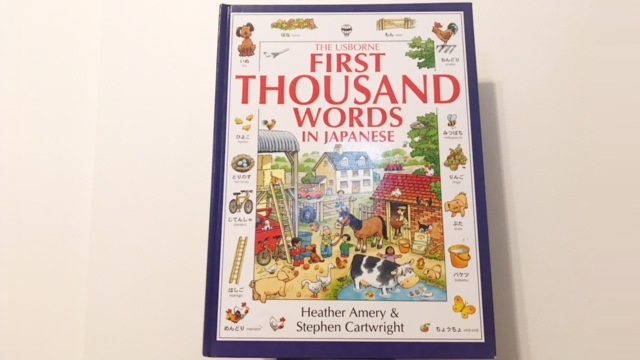Back in the day, a company called Usborne Books came out with a series of books known as “First Thousand Words” for the most commonly used languages that people wanted to learn. I happened to get the First 1,000 Words in Japanese book back when I was a kid.
It’s pretty cool and a neat way to learn a lot of Japanese vocabulary, along with how to read Japanese too.
I’ll go over the basic format of the book and then share my thoughts on the best way to use it.
What’s The Format Of The Book?
The book assumes that you know absolutely no Japanese when you start reading.
So the first thing it does is give you a chart of Hiragana and Katakana and then explain to you what these Kana scripts are and how to read them.
After that, it gives you pronunciation tips for the sounds of the Japanese language so that you can begin to practice speaking it.
Although it’s not extensive, the guide on how to speak is still pretty good for beginners. The book itself actually recommends that you listen to native people speaking Japanese so that you can combine your understanding of how to pronounce words with some auditory experience.
The book then talks a little bit about Kanji and gives a few examples of it, but then states that there won’t be any kanji used in this book.
That’s probably a good thing since new people would already have to learn the two Kana systems, so there’s no need to add the even harder third writing system into the mix.
After all the introductions to the language are finished (it’s only two pages long) you then get right into the primary method used in the book: Pictures combined with Japanese Vocabulary.

As you can see, the book has a scene of a real life situation and it is then filled with pictures with the Japanese words written in both Kana and the English alphabet (in case you need it).
The first half of the book is like this, where you see a scene in a park and then learn lots of different useful vocabulary for it, like the animals you might see there, the kinds of games kids might play there (with a kite, or a slide), and the parts of nature that are naturally there such as trees or ponds.
But then the second half of the book takes a slightly different approach and presents a singular theme instead of an overall scene.
So the theme might be about animals, numbers, or even different types of sports.
Finally, at the very end of the book there are all of the words lists that show the English translation of the Japanese words (no pictures this time) just in case you weren’t exactly sure what a particular item was when you learned the Japanese word for it.
The Teaching Method Used In The Book
The primary way that this book teaches you Japanese is by showing you a picture of something, and then giving you the Japanese word for it.
If this sounds familiar, it’s because this is how pretty much everyone in the world learns their native language.
You see something for the first time, point to it and look at your parents with a curious look on your face, and they tell you it’s a “duck.”
This method of omitting English and only using Japanese to teach is also one of the biggest selling points of the well-known language company Rosetta Stone.
So if you’ve been thinking about getting Rosetta Stone because of the teaching method they use, you can pretty much do the same thing (for a fraction of price) with this book.
Personally I think that only using Japanese to teach Japanese works really well for things like vocabulary, and kind of terrible for things like grammar.
In other words, concrete things are easy to pick up in Japanese alone. It’s the abstract stuff that you really want an explanation on in English so that you can quickly understand how to use it in Japanese.
Basically what I’m trying to say is that, the book uses an excellent way to teach you new words and then it stops there because this particular method doesn’t work very well with the harder stuff.
How Should You Use This Book?

This is really a book for people who are just starting out with learning Japanese. It’s great because it just focuses on teaching you lots and lots of nouns, which are of course the easiest thing to learn in a new language.
But in addition to that, it provides lots of opportunities to memorize the two Kana scrips by giving you repeated exposure to it. So you’re going to learn to read Japanese as well.
If you are having a hard time remembering Hiragana or Katakana, then this book might be a good way for you to practice it and expand your vocabulary at the same time.
I believe that these types of books are primarily aimed at children, hence the reason it’s super simple and uses lots of vividly colored illustrations.
But since anyone who starts learning a new language is like a child for that particular language, I think anyone could find it to be a valuable resource.
Granted, it’s just words and no grammar at all. So you won’t be able to have a conversation with anyone in Japanese. This book does not teach phrases or sentences at all.
So think of the book as either a good introduction to the language, or a nice resource to use in combination with your primary Japanese course and such.
If that is something that you think is interesting, then you can check it out by clicking here.
Have you used similar books like this before? What are your thoughts on using pictures to help understand new words?
Let me know with a comment below!
Further Resources for Learning Japanese:
#3 Get My eBook (Secrets to Learning Japanese) for Free

またね!

I guess starting out it is ok to just learn some words in the Japanese language. We didn’t start speaking English from the first day we arrived. Being around the language all of my life is what taught me good grammar. At least what I call good grammar. I agree that even if this book is intended for children we are just like children when first introduced to a brand new subject. Does this First One Thousand Words book come in Spanish? That is a language I need to learn
Yeah, there should be a “first thousand words” book for each of the major languages that people learn. If I remember correctly, Spanish is actually the #1 language that English speakers choose to study, so it makes sense that there would be one for it.
This book definitely won’t teach you everything you need to know in a language, but it’s always a good idea to increase your vocabulary when you are able to.
A common strategy that people use is to label everything in their house with the target language’s word for it. This book would be a great way to get those words since you can look at it and compare the items to what’s in your house.
It’d also be a good book to take along with you when you visit some of the same areas, like a park or a party, and then you can match what you’re seeing in the real world with what’s in the book to memorize those new words as well.